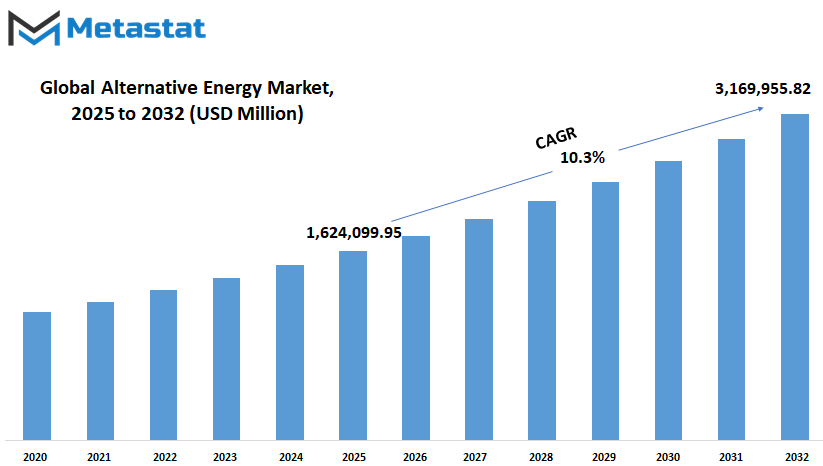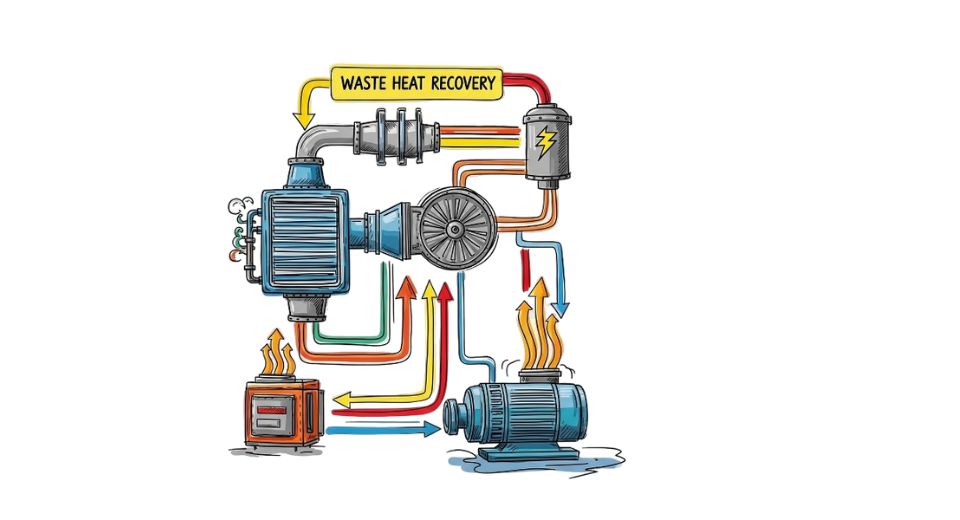MARKET OVERVIEW
The global alternative energy market is a changing industrial environment that will further redefine the way power is generated, transmitted, and consumed globally. This market encompasses a variety of technologies that will progressively diminish the world's dependence on traditional fossil fuel systems. It operates as an active industry within the larger energy sector, where innovation, global policy, and infrastructure development will be key forces driving it forward.
This market will not be defined by the technologies that it enables, like solar, wind, geothermal, hydroelectric, and new hydrogen systems. Rather, its delineation will be based upon the way these technologies engage the geopolitics, economic reorganization, and the reengineering of traditional supply chains. Although traditionally divided by region and regulatory climate, the global alternative energy market will become increasingly based on more centralized mechanisms of trade, certification, and technology exchange. This implies that definitions of the future will be less of individual capabilities and more of collective direction and functional integration of continents.
With nations rearranging their energy blueprints, this market's role will no longer be at the periphery of policy or capital investment. It will be a command node around which newer industrial designs will organize themselves. The global alternative energy market will not be isolated; its growth will be characterized by profound interdependencies with other sectors such as transportation, manufacturing, finance, and data infrastructure. Its structure will change relentlessly to fit this broader frame, rendering it considerably more complicated than a single-sector categorization would indicate.
The global alternative energy market will not be constrained by conventional supply-and-demand definitions. Instead, it will be dictated by modular, distributed systems where local generation becomes as important as utility-scale. The market will become more sophisticated through decentralization of the grid, peer-to-peer energy exchange, and integration of energy storage. Consequently, measures of assessing market dynamics will also change. Measurements will move from volume-based frameworks to those based on efficiency, stability, and flexibility.
This market will also redefine the lines between technology innovation and social systems. For example, areas previously without access to centralized power will become crucial interface points for energy democratization. The global alternative energy market will be a shaping force in rewiring not only how energy gets to consumers, but how communities engage with power systems on a daily basis. It will power both virtual and physical development, grounding new forms of societal function that rely on persistent and responsive power flows.
When characterizing the global alternative energy market, the discussion needs to move past technology or supply substitution. It needs to recognize a co-transformation in values, logistics, and systemic conduct. The future of this market won't be the replacement of one energy source by another; it will be the rethinking of the very energy production and consumption paradigm. As it develops, its contours will continue to be in flux, defined not by what it takes away, but by what it makes possible within global systems.
Global alternative energy market is estimated to reach $3,169,955.82 Million by 2032; growing at a CAGR of 10.3% from 2025 to 2032.

GROWTH FACTORS
The global alternative energy market is set to grow steadily in the years ahead as more countries recognize the urgent need to move away from fossil fuels. This shift is being driven by growing concerns about climate change and the need to reduce carbon emissions. More governments and industries are now focused on cleaner, greener solutions, which has pushed the demand for renewable sources like solar, wind, and hydropower. These sources are seen not just as better for the environment but also as a way to secure long-term energy independence. As fossil fuel reserves shrink and the cost of their extraction rises, alternative energy becomes a more appealing option.
One of the major reasons for the expected growth is the active role governments are playing in promoting renewable energy. Many countries are offering tax benefits, subsidies, and grants to both consumers and companies that invest in clean energy. Public and private sectors are also pouring money into building modern infrastructure to support these energy sources. For example, newer grids are being developed that can handle power from various renewable sources and distribute it efficiently. All of this creates a strong foundation for long-term growth and innovation in the energy sector.
Still, the road ahead is not without obstacles. Setting up alternative energy systems comes with high upfront costs. Building wind farms, solar fields, or hydro plants requires large investments. Additionally, installing the right infrastructure to deliver this energy on a wide scale is both time-consuming and expensive. There are also concerns about how reliable these sources can be. Since they often depend on weather or natural patterns, energy production can be inconsistent. For instance, solar panels can’t generate power at night, and wind turbines don’t work without wind.
Even with these challenges, the future of the global alternative energy market looks promising. One of the most encouraging trends is the pace of technological development. Scientists and engineers are finding better ways to store energy so that it can be used when production is low. Improvements in battery technology and smart grids are making it easier to balance supply and demand. As these solutions become more common, they will help solve many of the current limitations and make alternative energy more practical on a larger scale. The path may not be easy, but the direction is clear. As the world continues to prioritize sustainability, this market will likely become a central part of the global energy landscape.
MARKET SEGMENTATION
By Type
The global alternative energy market is expected to grow steadily in the coming years as the world shifts toward cleaner and more sustainable sources of power. With rising concerns over climate change, pollution, and the exhaustion of fossil fuels, many countries are investing in renewable energy options. This shift is not only driven by environmental needs but also by the growing demand for energy security, job creation, and economic development. As technology improves and production costs continue to fall, alternative energy is becoming a practical and cost-effective solution for many regions.
By type, the global alternative energy market is divided into several key segments, each offering unique benefits. Solar energy is one of the fastest-growing segments due to its wide availability and dropping equipment costs. Panels can now be found on rooftops, open fields, and even portable devices. Wind energy also holds a strong position, especially in areas with consistent wind patterns. It has seen large-scale projects being set up both on land and offshore, contributing significantly to the power grid in some nations. Hydropower, though one of the oldest forms of renewable energy, still plays a major role by using the movement of water to generate electricity. It is often favored for its reliability and storage capability through reservoirs.
Geothermal energy, while less common, taps into the heat stored beneath the Earth's surface and is known for providing a steady supply of power with low emissions. It is mostly used in specific regions where underground heat sources are accessible. Biomass energy uses organic materials such as plant waste and wood to produce energy. It helps reduce waste and provides an alternative to burning coal or oil. Other forms, including tidal and wave energy, are still being developed and tested. These options may become more popular in the future as research continues.
Looking ahead, the global alternative energy market will likely experience a surge in demand as countries aim for cleaner energy goals. Governments are expected to pass stronger laws supporting renewables, while private investors may fund more projects due to rising awareness and improved returns. As newer generations grow up with environmental issues at the forefront, the push for clean energy solutions will continue to gain speed. Innovation, policy support, and public demand will all work together to shape a future where clean energy becomes the standard rather than the alternative.
By Application
The global alternative energy market is growing steadily and will continue to play a major role in how energy is produced and used in the future. As traditional energy sources like coal and oil face challenges related to cost, pollution, and supply limits, more people, companies, and governments are turning to cleaner sources. These alternatives, such as solar, wind, hydro, and bioenergy, offer long-term solutions that help reduce carbon emissions while also meeting rising energy demands.
Looking ahead, the global alternative energy market will shape how the world powers homes, businesses, and entire industries. In the residential sector, more households will choose solar panels and small wind systems to reduce their dependence on the grid. Improved battery storage will make it easier for people to store energy for later use, even during cloudy days or at night. This not only helps with cutting down on electricity bills but also gives homeowners more control over their energy usage.
In commercial settings, the shift will be driven by both environmental goals and the need to cut operational costs. Businesses will install clean energy systems to power offices, shops, and production spaces. With better technology and falling equipment prices, it will become more common for companies to make these investments. At the same time, these changes will improve their public image and help meet local or global environmental targets.
The industrial sector will also see a larger shift. Heavy industries, which use a lot of energy, will begin to rely more on renewable sources. This will be encouraged by policy changes and market demands for cleaner production processes. By using solar thermal systems or biomass energy, factories can continue running efficiently while lowering pollution levels.
At the utility level, entire power grids will start moving toward cleaner energy. Large-scale wind farms, solar parks, and hydropower stations will become more common. These sources will feed directly into national and regional power systems, reducing the need for coal and gas plants. Smart grids and digital tools will also help manage the energy flow more efficiently, allowing power to be delivered where it's needed without much waste.
As the global alternative energy market grows across these areas residential, commercial, industrial, and utility it will help build a cleaner, more flexible energy future. The changes taking place now will lay the foundation for a world where clean energy is not just a choice, but a standard.
|
Forecast Period |
2025-2032 |
|
Market Size in 2025 |
$1,624,099.95 million |
|
Market Size by 2032 |
$3,169,955.82 Million |
|
Growth Rate from 2025 to 2032 |
10.3% |
|
Base Year |
2024 |
|
Regions Covered |
North America, Europe, Asia-Pacific Green, South America, Middle East & Africa |
REGIONAL ANALYSIS
The global alternative energy market is expected to play a central role in shaping the future of how energy is produced and consumed. As the demand for cleaner and more sustainable energy sources continues to grow, this market is set to expand in both size and importance. Governments, industries, and individuals are looking for solutions that reduce their dependence on traditional fossil fuels. This shift is not only driven by concerns about the environment but also by the desire for more stable and diversified energy systems. Technology will continue to push this movement forward, offering more efficient, affordable, and scalable solutions that make alternative energy more accessible to a wider range of people and countries.
Looking at its global structure, the global alternative energy market is divided into key geographic regions, each with its own pace of development and unique challenges. North America includes the United States, Canada, and Mexico, and is seeing strong growth due to supportive policies and technological innovation. The U.S., in particular, is investing heavily in solar and wind power projects. Canada and Mexico are also stepping up efforts to modernize their energy systems with cleaner options. In Europe, countries like the UK, Germany, France, and Italy are showing long-term commitment to alternative energy, driven by clear targets and government support. The rest of Europe is also gradually catching up, adopting clean energy practices in urban and rural settings alike.
Asia-Pacific is becoming one of the most dynamic parts of the global alternative energy market. Nations like India and China are rapidly scaling up their efforts, investing in solar farms, hydroelectric stations, and other forms of clean energy. Japan and South Korea are also making steady progress, especially in solar and battery storage technologies. The rest of Asia-Pacific is beginning to follow suit, aiming for solutions that match their energy needs with sustainability goals. In South America, Brazil and Argentina are leading the way, using their natural resources to support bioenergy and hydroelectric development. Other countries in the region are also making gradual improvements. The Middle East and Africa are in a growth phase, with GCC countries, Egypt, and South Africa making early moves toward renewable sources. While challenges remain, these areas show clear interest in building a future less reliant on traditional fuels. The global alternative energy market will continue to grow, bringing countries together in the shared goal of cleaner, more stable energy for generations to come.

COMPETITIVE PLAYERS
The global alternative energy market is gaining more attention as the world looks toward cleaner sources of power. As fossil fuel use faces increasing criticism and environmental concerns continue to grow, the demand for alternative energy is expected to increase steadily. Solar, wind, hydroelectric, and other renewable forms are no longer just supplements to traditional energy they are becoming core solutions. People and governments everywhere are starting to see the value in cleaner energy, not just for the environment but also for long-term cost savings and energy independence.
Several leading companies are helping to shape the future of this market. Businesses like NextEra Energy, Inc., Iberdrola, S.A., Vestas Wind Systems A/S, and Ørsted A/S are heavily involved in both producing and advancing new technologies in this space. These companies are not only investing in large-scale projects but are also working to improve efficiency and make renewable energy more reliable. For example, First Solar, Inc. and Canadian Solar Inc. are both involved in creating solar panels that can perform better even in less ideal conditions. Companies such as Siemens Gamesa Renewable Energy, S.A. and JinkoSolar Holding Co., Ltd. are working to improve wind and solar systems by lowering costs and increasing performance.
As time goes on, alternative energy is expected to grow stronger due to better battery storage, smarter grids, and support from public policies. Governments are offering incentives for clean energy projects, making it easier for companies to invest in large-scale developments. Firms like ABB, ACCIONA, EDF, Enel Spa, and Xcel Energy Inc. are already moving in this direction, improving power infrastructure and finding new ways to balance supply and demand. These companies are focused on making clean power more accessible to a wider population.
The future of the global alternative energy market will likely include more partnerships between tech companies and energy firms. As demand for electric vehicles and smart homes increases, so will the need for clean and dependable energy sources. Companies such as ReNew Power are already showing what can be achieved with a focus on renewable energy, especially in growing markets.
Over the next decade, this market will play a big role in how the world produces and uses energy. With continued investment and public interest, alternative energy could become the main source of power in many parts of the world. The progress made by today’s key players will shape what the energy world looks like tomorrow.
Alternative Energy Market Key Segments:
By Type
- Solar Energy
- Wind Energy
- Hydropower
- Geothermal Energy
- Biomass Energy
- Other
By Application
- Residential
- Commercial
- Industrial
- Utility
Key Global Alternative Energy Industry Players
- NextEra Energy, Inc.
- Iberdrola, S.A.
- Vestas Wind Systems A/S
- Ørsted A/S
- First Solar, Inc.
- Siemens Gamesa Renewable Energy, S.A.
- ABB
- Canadian Solar Inc.
- JinkoSolar Holding Co., Ltd.
- ACCIONA
- EDF
- Enel Spa
- Xcel Energy Inc.
- ReNew Power
WHAT REPORT PROVIDES
- Full in-depth analysis of the parent Industry
- Important changes in market and its dynamics
- Segmentation details of the market
- Former, on-going, and projected market analysis in terms of volume and value
- Assessment of niche industry developments
- Market share analysis
- Key strategies of major players
- Emerging segments and regional growth potential








 US: +1 3023308252
US: +1 3023308252






